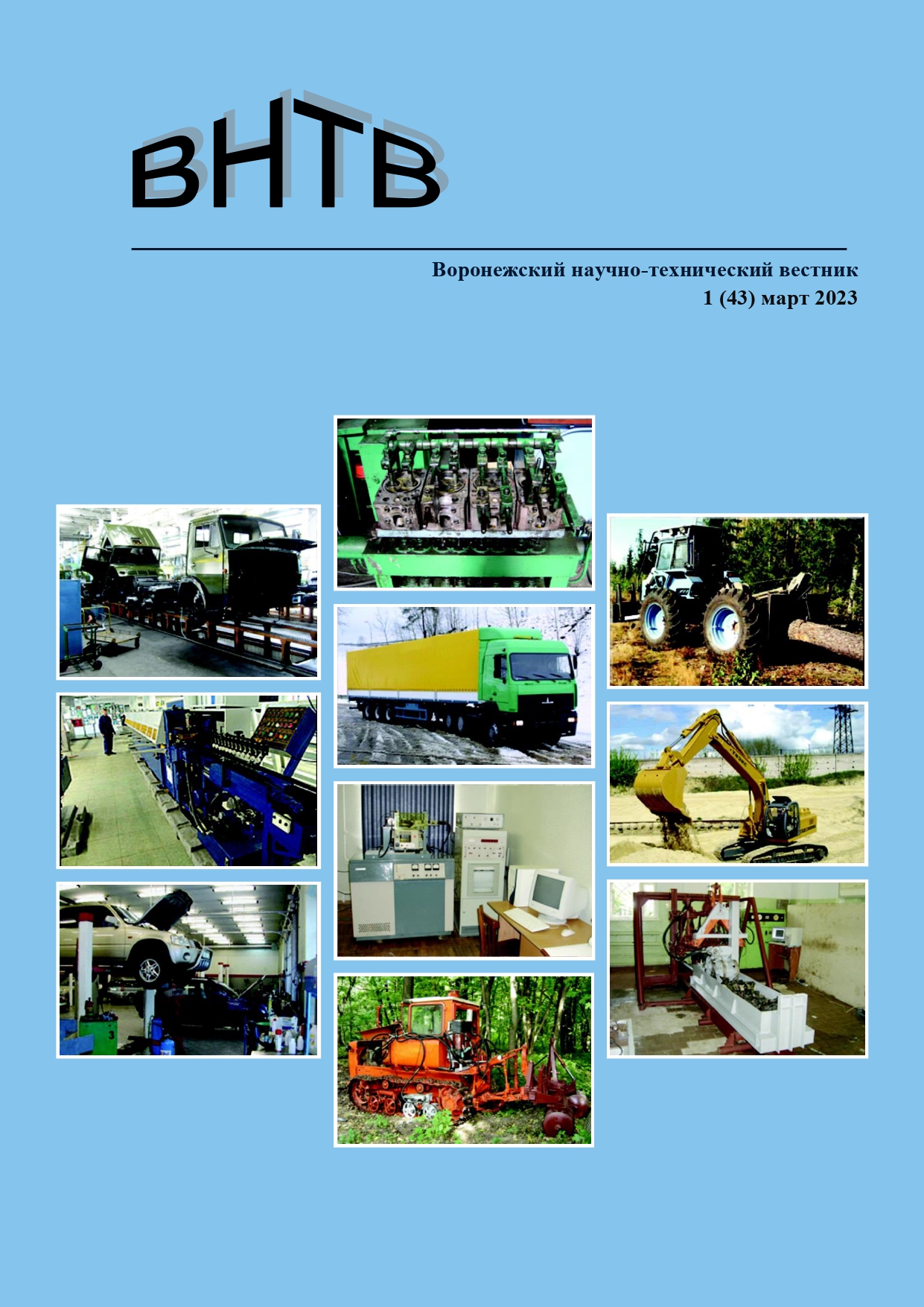Russian Federation
UDC 621.03
This work is devoted to revealing the electrophysical regularities of the process of jet electrolytic-plasma processing of materials. Electrostatic studies were carried out in the COMSOL Multiphysics program. The influence of the voltage between the electrodes, the geometrical parameters of the hollow cathode tube, the shape of the drop, and the height of the interelectrode gap on the strength and distribution of the electric field is estimated. The data on the magnitude and location of the maximum electric field strength have been refined. It is shown that the studied parameters significantly affect the surface morphology in the zone of formation of an electric discharge, which is confirmed by the results of the experiments. The modeling of the treatment zone with a jet of electrolyte plasma was performed for different parameters. It is shown that there are competing mechanisms of material removal. Surface modeling for different types of machining was carried out and the parameters of the layer to be removed were calculated. The research results can be applied to the development of technological processes for jet electrolytic-plasma treatment of turbine blades.
JET, ELECTROLYTE, ELECTROSTATICS, SURFACE MORPHOLOGY, CURRENT LEAD, TURBINE BLADE, MODELING
1 Состояние вопроса исследования и актуальность работы
Возрождение технологического суверенитета России возможно, как за счет снижения доли импорта готовых технологических решений, так и за счет применения отечественных наукоемких технологий позволяющих снизить затраты на производство и получить более качественную продукцию [1-5].
Одной из таких технологий является технология струйной электролитно-плазменной обработки поверхности и объема металлических изделий. На сегодня существует две основных разновидности данной технологии. Первой и основной технологией является обработка изделий в электролитической ванне погружением изделия [6-12]. Второй на сегодня еще довольно редко применяемой технологией является обработка поверхности и объема направленной (фокусированной) струей электролита или областью электролитной плазмы, сформированной электромагнитным полем [13-22]. Высокая скорость обработки в электролитной ванне и простота обработки позволяет обрабатывать сложные криволинейные изделия и неглубокие полости за технологический цикл 5-10 мин. При этом площадь изделий может составлять 1-2 м². К недостаткам метода можно отнести округление тонких кромок на ребрах и вершинах, наличие дефектов в виде эрозионных лунок в середине поверхности, значительную мощность источников питания, увеличивающих стоимость обработки и наличие большого объема паров от зеркала электролитической ванны, что снижает экологическую безопасность работ. Струйная электролитно-плазменная обработка является альтернативой обработки в электролитической ванне. Струйная обработка характеризуется локальным воздействием области электролитной плазмы на поверхность изделия, что позволяет проводить обработку изделия только в технологически обоснованных областях. Струйная обработка обладает определенными преимуществами, такими как возможность создания в заданной области электролитной плазмы с более высокими показателями напряженности электрического поля между катодом и анодом (изделием), более высокой скоростью удаления поверхностных слоев [8-17], более высокой скоростью достижения заданных параметров шероховатости, меньшими параметрами шероховатости при обработке, большей глубиной съема материала анода [18], более высокой экологичностью процесса и на несколько порядков меньшей мощностью затрачиваемой на процесс обработки. Однако применение струйных методов сдерживается за счет необходимости автоматизации процесса, а также недостатка знаний для разработки промышленно готовой технологии. Цель работы – установить связь между электрофизическими закономерности и изменениями морфологии поверхности после струйной электролитно-плазменной обработки.
2 Материалы и методы
Работа состояла из двух частей, экспериментальной и расчетной. Расчетная часть работы выполнялась с использованием программ COMSOL Multiphysics, Wolfram Mathematica, SolidWorks.
В программе COMSOL Multiphysics использовался расчетный модуль «Электростатика» для стационарной 2D-модели процесса струйной электролитно-плазменной обработки поверхности. Моделирование проводили с целью оценки влияния основных параметров процесса, напряжения между электродами, геометрическими параметрами трубки полого катода, формы капли и высоты межэлектродного промежутка на напряженность и геометрию электрического поля.
Экспериментальную часть работы проводили на установке струйной электролитно-плазменной обработки, созданной в Высшей школе машиностроения СПбПУ [18-22]. Назначение данного оборудования – формирование струйного электрического разряда (ЭР) в межэлектродном зазоре между поверхностью обрабатываемой детали и токоподводом (рис.1.). Объем электролита Q замеряли мерным химическим стаканом 2 класса точности с ценой деления 0,02 мл. Напряжение измеряли цифровым мультиметром UT61B с точностью измерения ± (0,5 %+1). В качестве электролита использовали хлорид натрия. Концентрацию электролита k меняли в диапазоне от 22,5-100 мг/л
Морфологию поверхности изучали сшиванием изображений на автоматическом микротвердомере FM-300 (Япония) с помощью программы Thixomet Pro (Россия).
|
|
|
|
|
а) |
б) |
в) |
а) – формирование электролитической капли; б) – касание электролитической капли поверхности анода; б) – формирование электролитической струи (моделирование в графическом редакторе Cinema 4D)
Рисунок 1 – Основные этапы развития струйного электролитно-плазменного разряда
- Электрофизическое моделирование зоны обработки в программном продукте COMSOL Multiphysics
Оценку потенциала для среды с разными электрофизическими свойствами проводили в соответствии с уравнением:
(1)
где U – потенциал электростатического поля; ɛ – диэлектрическая проницаемость; ρ – плотность объемных свободных зарядов.
При этом заряды расположены только на металлическом катоде и металлическом аноде. В этом случае плотность объемного заряда соответствует выражению:
1. Stepanova, T. D. Technological sovereignty of Russia as an element of economic security Economic journal Ekonomika: yesterday, today, tomorrow Vol. 12, No. 9A, 2022. p. 567-575.
2. Institutional aspects of the innovation economy: monograph / T. I. Bezdenezhnykh, V. V. Shapkin, O. V. Ugolnikova [and others]; St. Petersburg State University of Service and Economics. - St. Petersburg: St. Petersburg State University of Service and Economics, 2012. - 131 p. - ISBN 978-5-228-00590-7. - EDN TLVEJZ.
3. Popova, A. I. The North-West region in the system of world economic relations / A. I. Popova // Integration of the economy into the system of world economic relations: Collection of scientific papers of the XVII International Scientific and Practical Conference, St. Petersburg, October 23-25, 2012. - St. Petersburg: Federal State Autonomous Educational Institution of Higher Education "Peter the Great St. Petersburg Polytechnic University", 2012. - P. 100-102. - EDN WDWGQF.
4. The role of the university in the integration of education, science and business / S. I. Golovkina, A. I. Popova, S. A. Chernogorsky, N. V. Valebnikova // University as a factor in the modernization of Russia: history and prospects (to the 55th anniversary of CGU named after I.N. Ulyanov): Proceedings of the International Scientific and Practical Conference, Cheboksary, October 18, 2022 / Editorial Board: A.Yu. Alexandrov [i dr.]. - Cheboksary: Limited Liability Company "Publishing House "Sreda", 2022. - P. 138-140. - EDN NERYTD
5. Provision of stages of the life cycle of steam turbine blades using ultrasonic testing / A. I. Popova, A. I. Popov, V. S. Medko, M. I. Tyukhtyaev // Metallobrabotka. - 2013. - No. 5-6 (77-78). - P. 43-47. - EDN SBOFBP.
6. Alekseev Yu.G., Korolev A.Yu., Parshuto A.E., Niss V.S. Electrolyte-plasma treatment under non-stationary modes in a high-gradient electric field. Science and Technology. 2017;16(5):391-399. https://doi.org/10.21122/2227-1031-2017-16-5-391-399
7. Pulsed electrolytic-plasma technologies for dimensional and finishing processing of metal materials / A. Yu. Korolev, V. S. Niss, Yu. G. Alekseev [et al.] // Powder metallurgy: surface engineering, new powder composite materials. Welding: Proceedings of the 12th International Symposium. In 2 parts, Minsk, April 07-09, 2021 / Editorial Board: A.F. Ilyushchenko (editor-in-chief) [and others]. - Minsk: Republican Unitary Enterprise "Publishing House "Belarusian Science", 2021. - P. 87-93. - EDN QQBOVV.
8. Danilov, I.; Hackert-Oschätzchen, M.; Zinecker, M.; Meichsner, G.; Edelmann, J.; Schubert, A. Process Understanding of Plasma Electrolytic Polishing through Multiphysics Simulation and Inline Metrology. Micromachines 2019.10, 214. https://doi.org/10.3390/mi10030214.
9. Zakharov, S. V. Ionization model of electrolytic-plasma polishing / S. V. Zakharov, M. T. Korotkikh, E. V. Gonibesova // SPbPU Science Week: Proceedings of a scientific conference with international participation. In 2 parts, St. Petersburg, November 18-23, 2019. - St. Petersburg: Polytech-Press, 2020. - S. 255-258. - EDN PNORZK.
10. P. Gupta, G. Tenhundfeld, E.O. Daigle, D. Ryabkov, Electrolytic plasma technology: Science and engineering-An overview, Surface and Coatings Technology, Volume 201, Issue 21, 2007, Pages 8746-8760, ISSN 0257-8972, https://doi.org/10.1016/ j.surfcoat.2006.11.023.
11. Danilov, I.; Hackert-Oschätzchen, M.; Schaarschmidt, I.; Zinecker, M.; Schubert, A. Transient Simulation of the Removal Process in Plasma Electrolytic Polishing of Stainless Steel. In Proceedings of the COMSOL Conference 2018, Lausanne, Switzerland, 22-24 October 2018; Available online: https://www.comsol.com/paper/download/573171/danilov_paper.pdf (accessed on 10 December 2018).
12. Zakharov, S. V. Comparative analysis of electrolyte-plasma technologies / S. V. Zakharov, A. I. Popov // Electrophysical methods of processing in modern industry. Special issue: additive technologies: Proceedings of the III International Scientific and Practical Conference of Young Scientists, Postgraduates and Students, Perm, December 11-12, 2019. - Perm: Perm National Research Polytechnic University, 2020. - P. 64-67. - EDN KVBMJZ.
13. Quitzke, Susanne & Kröning, Oliver & Safranchik, Daniel & Zeidler, Henning & Danilov, Igor & Martin, André & Böttger-Hiller, Falko & Essel, Shai & Schubert, Andreas. (2022). Design and setup of a jet-based technology for localized small scale Plasma electrolytic Polishing. Journal of Manufacturing Processes. 75. 1123-1133.https://doi.org/10.1016/j.jmapro.2022.01.064.
14. Krishna Kumar Saxena, Jun Qian, Dominiek Reynaerts, A tool-based hybrid laser-electrochemical micromachining process: Experimental investigations and synergistic effects, International Journal of Machine Tools and Manufacture, Volume 155, 2020,103569, ISSN 0890-6955, https: //doi.org/10.1016/j.ijmachtools.2020.103569.
15. Quitzke, S., Martin, A., Schubert, A.: Influence of ignition and polishing phase on jet shape and electric current in jet-plasma electrolytic polishing. In: Proceedings of the 21st International Conference of the European Society for Precision Engineering and Nanotechnology, EUSPEN 2021, pp. 165-168 (2021)
16. Popov, A.I., Fumin, A.S., Novikov, V.I., Teplukhin, V.G., Veselovsky, A.P. (2023). Peculiarities of Contact Interaction of an Electrolytic Plasma with a Surface in Jet Machining of Materials of Turbine Blades. In: Radionov, A.A., Gasiyarov, V.R. (eds) Proceedings of the 8th International Conference on Industrial Engineering. ICIE 2022. Lecture Notes in Mechanical Engineering. Springer, Cham. https://doi.org/10.1007/978-3-031-14125-6_71
17. Wu, Y., Wang, L., Zhao, J. et al. Spray plasma electrolyte polishing of GH3536 superalloy manufactured by selective laser melting. Int J Adv Manuf Technol 123, 2669-2678 (2022). https://doi.org/10.1007/s00170-022-10283
18. High-Speed Dimensional Processing of Metallic Materials with an Environmentally Friendly Jet Electrolyte-Plasma Method / A. Popov, A. Popova, A. Fumin [et al.] // Mechanisms and Machine Science (book series). - 2022. - Vol. 108 mms. - P. 481-489. - DOIhttps://doi.org/10.1007/978-3-030-87383-7_52. - EDN SEEEPN.
19. Patent No. 2623555 C1 Russian Federation, IPC C25F 7/00. Installation for electrolytic-plasma treatment of turbine blades: No. 2016120180: Appl. 05/24/2016: publ. 06.27.2017 / A. I. Popov, M. M. Radkevich, V. N. Kudryavtsev [and others]; the applicant is the Federal State Autonomous Educational Institution of Higher Education "Peter the Great St. Petersburg Polytechnic University" (FGAOU VO "SPbPU"). - EDN USJMHW.
20. Patent No. 2656318 C1 Russian Federation, IPC C23C 14/35. Magnetron Spray Head: No. 2017111428: Appl. 04/04/2017: publ. 06/04/2018 / A. I. Popov, M. M. Radkevich, V. S. Medko [and others]; the applicant is the Federal State Autonomous Educational Institution of Higher Education "Peter the Great St. Petersburg Polytechnic University" (FGAOU VO "SPbPU"). - EDN UQSEXB.
21. Popov, A. I., Radkevich, M. M., Novoselov, M. V. Peculiarities of electrolytic-plasma polishing of stents, Technology of Metals. - 2019. - No. 5. - S. 24-29. - DOIhttps://doi.org/10.31044/1684-2499-2019-5-0-24-29. - EDN UIJGJG.
22. Popov, A. I., Radkevich, M.M., Teplukhin, V.G.: Thinnest finishing treatment with a focused jet of electrolytic plasma. In: Evgrafov, A.N. (ed.) Advances in Mechanical Engineering. LNME, pp. 139-149. Springer, Cham (2020). https://doi.org/10.1007/978-3-030-39500-1_15














